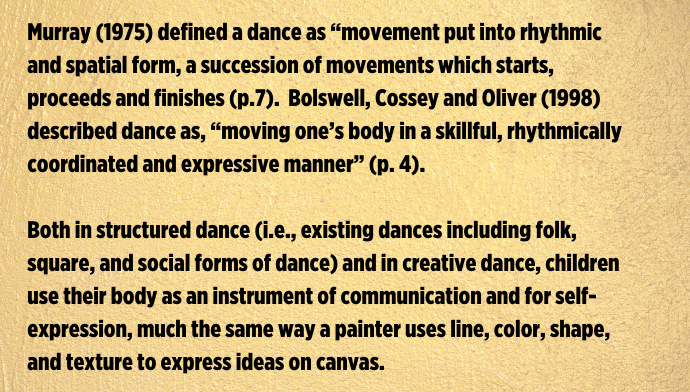In mid-March, 2020, as I prepared to teach my West Chester University physical education teacher candidates their seven-week dance class, I never expected it would be from my new make-shift dance studio, my dining room! Yes, COVID-19 necessitated that I teach a course I have never taught virtually, virtually! While we continue to “shelter at home” the movement form of dance provides those who live alone and those who have families an opportunity to engage in an expressive movement form that can stimulate creativity, develop health-related fitness components (e.g., aerobic and muscular endurance) as well as skill-related fitness abilities (e.g., coordination, balance, reaction time). So, let’s establish just what dance is….

Excerpt from Cleland Donnelly, F., Mueller, S. & Gallahue, D. (2017). Developmental physical education for all children – Theory into practice (5th ed.). Champaign, IL: Human Kinetics Publishers.
There are four main genres of dance contemporary (e.g., modern, hip-hop), social/ballroom, cultural and creative dance. COVID-19 really stimulated the creative energies of so many folks. Check out the “Lock Down Boogie!"
Even though several choreographic variables were employed (i.e., canon, entrance and exits, different levels) it does support the notion that everyone can and should dance!
So, given that I could not teach social/ballroom dance due to the need for a partner, I began my dance unit with cultural dance, specifically the Philippine dance of tinikling, and then I taught the Samoan dance SaSa. Here are links of very skillful dance groups performing Tiniking and a Sasa.
You can create your own Tinikling sequence of steps that are much easier than this video and instead of using tinikling poles you can put down tape on your floor or use jump ropes as poles. In addition, there are many versions of the SaSa dance. Please check out the SaSa I posted on Twitter (@ClelandFran
I did teach the basic step of swing dance without the use of a partner, but it really isn’t that much fun. Swing dance is all about the turns and moves you can do with your partner!
I then focused on hip-hop. Hip hop has a rich history and is very accessible. I immediately went to YouTube and found Mike Peeles’s hip-hop routines to work very well with my physical education teacher candidates. Not only are his routines interesting, but they are not overly complicated, he teaches the sequences very well (repeats every 8 counts several times) and his teaching presence is so charismatic.
I also embedded some country line dance. There are several YouTubes resources for that as well. Two great ones to start with are Good Time and Footloose.
NDEO has several COVID-19 free resources, as well as dance enthusiast Melanie Levenberg of dancepl3y:
 |
Dr. Fran Cleland Donnelly just completed her 25th year as a Professor at West Chester University within the Department of Kinesiology. She is also the Assistant Chair and Director of the Health and Physical Education Teacher Certification Program. Fran is a published author and experienced presenter with expertise in children’s physical education as well as K-12 dance education. Fran is a long time PSAHPERD member and past-president, as well as the 2017-2018 past president of SHAPE America. |
